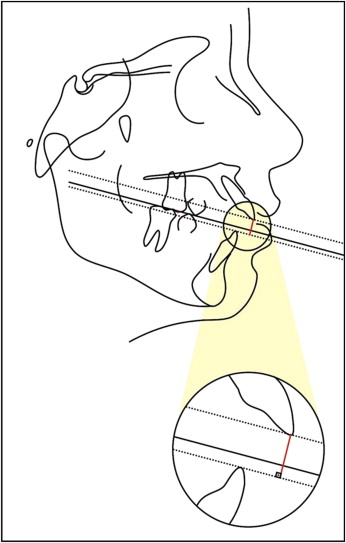Introduction
The objective of this study was to evaluate the long-term stability of open-bite surgical-orthodontic correction.
Methods
Thirty-nine patients at an initial mean age of 20.83 years were evaluated cephalometrically at pretreatment (T1), immediately after treatment (T2), and at the last recall (T3), with a mean follow-up time of 8.22 years. The surgical protocol included single-jaw or double-jaw surgery. Because the patients had different anteroposterior malocclusions, the sample was divided into a Class I and Class II (I-II) subgroup (3 Class I, 20 Class II malocclusion patients) and a Class III subgroup (16 patients). The dentoskeletal characteristics of the total sample and the subgroups were compared at T1, T2, and T3 with dependent analysis of variance (ANOVA).
Results
Overbite relapse in the posttreatment period was statistically significant in the whole sample and the Class I-II subgroup. Fourteen patients of the whole sample (35.9%) had clinically significant open-bite relapse (negative overbite).
Conclusions
There was a statistically significant open-bite relapse in the overall sample and in the Class I-II subgroup. The clinically significant values of long-term open-bite correction stability were 64.11%, 47.82%, and 87.50% in the overall sample, the Class I-II subgroup, and the Class III subgroup, respectively.
Editor’s comment
You have proposed to correct a severe anterior open bite with orthognathic surgery combined with fixed appliances to improve facial esthetics and occlusal function. The patient, a 35-year-old woman, wonders whether there is any way to get her front teeth together without surgery. You know that a surgical approach is critical for reducing her face height and improving her facial balance. Without hesitation, you assure the patient that her resulting occlusion will be more stable with the surgical plan. You explain the reality of posttreatment relapse after conventional orthodontic treatment to close an open bite. But is this a fair comparison? Does incorporating jaw surgery into the treatment plan lead to greater stability than orthodontic treatment alone? Researchers from Bauru, Brazil, designed their study to answer this clinical question.
This is a well-designed, long-term study, although the sample of 39 adults is quite diverse. The mix of subjects includes several malocclusions, different surgical procedures, different fixation methods, and different x-ray machines. The study’s strength is its posttreatment follow-up interval: a mean time of 8.22 years. The investigators carefully described details of the various malocclusions treated. Open-bite relapse for those treated with maxillary surgery only was less than for those who had bimaxillary surgery, although the difference was not statistically significant. Overall, 35.89% of the sample had clinically significant open-bite relapse. The Class I-II and Class III subgroups had clinically significant relapses of 52.18% and 12.50%, respectively. Open-bite relapse was considered clinically significant when a negative incisor overlap was observed 8.2 years posttreatment, because this occlusal condition compromises the patient’s esthetics and functions.
With this bit of clinical information, every orthodontist should realize that the severity of the associated dentoskeletal discrepancies and the patient’s needs should be the primary factors for requiring surgical intervention and not closure of the open bite per se, intending a more stable occlusal result.

| Variable | Total sample n = 39 |
Class I-II subgroup n = 23 |
Class III subgroup n = 16 |
|---|---|---|---|
| Clinically significant relapse | 14 patients (35.89%) |
12 patients (52.18%) |
2 patients (12.50%) |
| Clinically stable correction |
25 patients (64.11%) |
11 patients (47.82%) |
14 patients (87.50%) |
Stay updated, free dental videos. Join our Telegram channel

VIDEdental - Online dental courses


